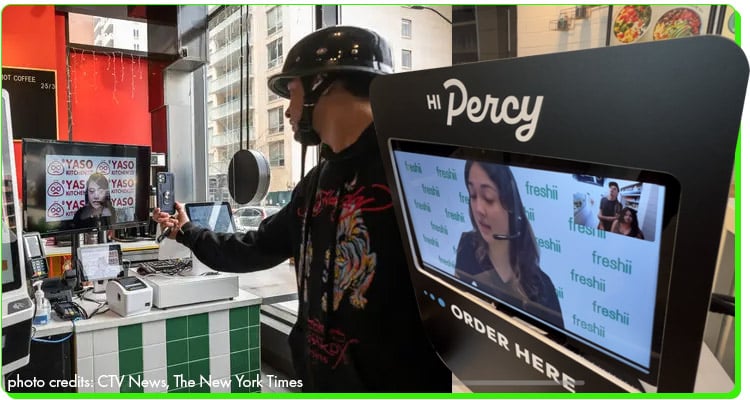A New York City restaurant owner found a unique solution for the city’s high operational costs and labor shortages—outsourcing cashiers from the Philippines via Zoom.
This viral trend has workers in the Philippines handling cashier duties remotely for eateries across the city.
For some, it’s a creative way to leverage technology and a remote workforce. Others think it’s borderline exploitative.
Let’s take a look.

The Rising Trend of Remote Cashiers
As we mentioned earlier, NYC restaurants are facing staffing shortages.
The solution? Outsourcing to the Philippines, where a well-established Business Process Outsourcing (BPO) industry has a rich pool of skilled, English-speaking professionals. Many of them also have extensive experience and training in customer service roles.
These remote cashiers manage orders and process payments virtually via Zoom in real-time, interacting with customers through mounted iPads at checkout counters.
Aside from the convenience, this arrangement also enables NYC restaurants to save significantly on wages.

Operational Benefits and Challenges
However, the advantages of using remote cashiers extend beyond mere cost savings.
This setup also mitigates the impact of local labor shortages and provides scheduling flexibility that is harder to achieve with in-house staff.
Additionally, the integration of technology streamlines operations, reducing the chances of human error and enhancing the customer experience with quick service.
However, this model isn’t without its challenges, like time zone differences and internet connectivity issues as well as occasional power outages in the Philippines.
There’s also the lack of a personal touch. Remote cashiers can perform most functions of an in-person cashier, but the physical distance greatly limits building rapport and a personal connection with customers.
However, despite the challenges of adjusting to American service standards and overcoming minor language barriers, some customers enjoy the novel experience.

A Global Comparison
Interestingly, this set-up isn’t really new…or uncommon, especially in other Western countries where the costs of running a business can be quite high.
In Australia, for example, more and more SMEs are turning to remote and hybrid work, particularly for administrative and customer service roles.
Companies discovered that hiring remote staff cuts down labor costs while providing access to a broader talent pool.
However, it takes the right cultural fit and effective communication for this approach to succeed.

The Future of Customer Service?
Employing remote cashiers from the Philippines may seem like a small change in the operational blueprint of NYC restaurants.
Yet it’s also showing us the future of customer service- and could be the first step towards a more interconnected and technologically empowered global workforce.
Remote Staff, a company that specializes in connecting SMEs with Filipino talent, has been helping Western companies do just that for 16 years and counting – but with a strong set of ethical regulations in place to protect all parties involved.
We differ in our approach by securing a high degree of cultural and operational compatibility.
We provide continuous support, fostering an environment that values the contributions and well-being of our offsite workers – while upholding cultural and operational compatibility to give our clients the results they want.
Whether you run a restaurant in New York or an e-commerce company in Florida (or anywhere else in the United States), outsourcing can prove to be an effective solution.
When you’re ready to discover how far your business can go with the right talent (and a strong outsourcing partner behind them), click here to schedule a callback today.
Darren Aragon is a multifaceted writer with a background in Information Technology, beginning his career in research at Pen Qatar and transitioning through customer service to a significant role at Absolute Service, Inc. His journey into freelance writing in 2021 has seen him excel across various niches, showcasing his adaptability and deep understanding of audience engagement.






